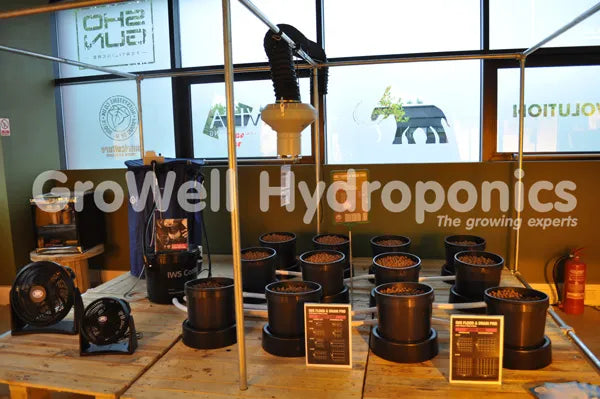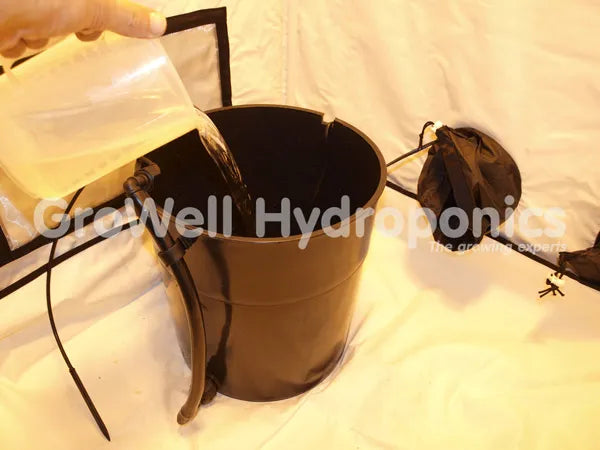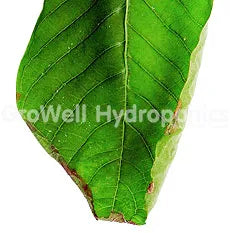![[Leaf Health] How to Stop Leaf Damage](http://www.growell.co.uk/cdn/shop/articles/take-a-leaf-out-of-the-growell-book---keep-your-plants-healthy.jpg?v=1673371529&width=1100)
[Leaf Health] How to Stop Leaf Damage
Noticed leaf damage? You're not alone. Leaves are one of the first things to show visible signs of damage.
The most common causes are nutrient deficiencies, overfeeding, underfeeding, over-transpiration and wind burn. Here's how to spot, and respond to, leaf damage
Emergency Action
Act quickly to minimise damage.
Move Lights Up
Move lights up a further 30cm from your plants.
Doing this will immediately reduce the demand on plants and speed up recovery, whatever the problem is.
It'll also relieve damage caused by over-transpiration and heat stress.


Check Roots
If roots look mushy or pull apart easily, your nutrient solution is probably too warm. This reduces oxygen content, allowing root diseases to take hold. If you're unlucky, Pythium or another root disease could already have taken hold.
To prevent Pythium and 99.99% of other root diseases, use Silver Bullet Roots in your growing system.,
Check Oscillating Fans
Make sure your fans blow directly at your lamp or blow up through the plants. Never point them at the 'light facing' tops of leaves. Doing this can cause wind burn and leaf damage.
DiffuseAirs are great - they never cause wind burn.
Check your humidity
If your humidity is too low, increase the size of air intake holes. If this doesn't work, you can use a humidifier.


Check your "lights off" temperature
Cold nights can cause leaves to lighten, as well as leaf tip and margin damage. Try not to bring air that's too cold into your grow room.
Your ‘lights off’ temperature should be 10oC below your ‘lights on’ temperature. This'll usually be around 18-20oC. You can use a Grow Room Heater if you need to.
Change your Nutrient Strength
To correct overfeeding or underfeeding, you will need to fix your nutrient strength.
First, turn your pump off.
Next flush any cubes, pots, and slabs through with an appropriate strength solution (or slightly weaker nutrient solution, if you've been overfeeding).
You can even use a Flushing Solution. Add SuperThrive and Liquid Oxygen if possible.

Then, pump out all of the old nutrient solution (including the flush).
Lastly, add a fresh nutrient solution to the system -change the strength to what it should now be. If overfeeding was the problem, you don't need to go to the extreme of switching to water only.
Nutrient Deficiencies
Nutrient deficiencies are rare in hydro systems. This is especially true of calcium and magnesium
If you do get a micro deficiency, it's most likely caused by a nutrient 'lock out', the result of:
- Overfeeding
- Excessively tweaking pH with phosphoric acid in hard water
- Using the wrong formulation (hard, soft, universal)
Either way, these sort of deficiencies aren't common. The main indicators of a micro deficiency are:
- rust spots
- lightening between leaf veins
- leaf damage
However, the same symptoms are nearly always environmentally caused rather than a deficiency.

Non-mobile deficiencies
Your plant has no control over the distribution of non-mobile elements - like iron, calcium and magnesium. So these deficencies always show first on new shoots & leaves.
If only lower, bigger leaves are damaged, the problem will be:
- natural leaf loss
- a slight main element (NPK) deficiency
- a slight environmental problem
NPK deficiencies
Main elements are mobile, so your plant can move them to wherever they are needed.
Obviously, plants will move these main elements to where most activity is taking place. Therefore, any deficiencies first show up on established leaves at the base of the plant, where relatively little is happening.
If your plants start to lighten in colour and you're losing a few big leaves, you may need to increase your feed strength slightly.
Don't forget that it's normal for plants to shed big lower leaves after a while so that younger leaves nearer the light can replace them.
Try to keep plants a nice green colour - not too light or “limey” (underfed) or dark green (a bit too well fed).
Over-feeding
A dead giveaway is downwards hooking on the leaf tips (and sometimes leaf margins).
In the early stages, plants become a dark, dull green with some tip burn. The leaves then curl down in an attempt to retain moisture, as the high nutrient strength sucks out water (reverse osmosis).
It does this in an attempt to balance the pressure across the root membrane.
Under-feeding
The whole plant will lighten in colour. It'll be worst on the lower parts of the plant. There will be no associated leaf curl. If the lightening is only at the top of the plant. it may just be caused by bleaching from the light.

Wind Burn
This is very common and easily treated.
Windburn is caused by oscillating fans blowing heavily on the tops of leaves, where there is a lot of light and heat.
This sucks all the moisture out of leaves, causing tips and margins to curl up. Leaves die back from the tip, go a golden colour and become crispy.
Over-transpiration
You may not notice the early symptoms, as they're subtle.
Leaves lose their thick, healthy smoothness and appear a little mottled in colour, maybe slightly lighter between the leaf veins. This occurs because the leaf has sweated too much in the heat and light.
The leaf tips and margins may also curl up sometimes as the leaf tries to retain moisture.
The real damage only shows a couple of weeks later, as:
- Rusty spots appear between veins
- Leaf colour is lost (generally leading to the leaf dying)
Over-transpiration is more of a problem during vegetative growth, when lights are on the longest (18 hours!). The main reason lots of multi-light gardens add CO2 is to help with the heat problems in vegetative growth.



